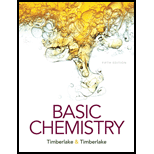
Concept explainers
Interpretation:
“The volume of ” should be calculated.
Concept Introduction:
Here we have used the concept of ideal gases and its equation.
► Ideal gases are the gases which obeys the ideal gas equation under all conditions of temperature and pressure. The ideal gas equation can be obtained by combining the Boyle’s Law, Charles’ Law and the
► Boyle’s Law: It states that at constant temperature, the pressure is inversely proportional to the volume
► Charles’ Law: It states that at constant pressure, the volume of the gas is directly proportional to the temperature
► Avogadro’s Law: It states that equal volumes of all gases under similar conditions of temperature and pressure contains the same number of molecules
Volume of the gas Number of molecules
Moles of the gas
► Combining these three laws, we get the ideal gas equation
where, universal gas constant
is the volume
is the number of moles
is the pressure
is the temperature
► The relation between number of moles and mass of the gas is
where, is the mass of the gas,
is molar mass of the gaseous compound
► Molar mass is the number of times a molecule of the substance is heavier than the mass of an atom of .
► We have used the concept of stoichiometry where when reactants undergo a reaction, they form product in certain ratio based on the number of moles associated with the elements which participated in the reaction.
Thus, in stoichiometric calculation we come across chemical formula and chemical equation.
► A chemical equation directly states that the substance and the number of moles of each substance which are involved in the chemical reaction.
Given:
Mass of
Pressure of the gas,
Temperature of the gas,
Want to see the full answer?
Check out a sample textbook solution
Chapter 11 Solutions
Basic Chemistry (5th Edition)
- What is the product of the reaction? F3C. CF3 OMe NaOH / H₂Oarrow_forwardWhat would you expect to be the major product obtained from the following reaction? Please explain what is happening here. Provide a detailed explanation and a drawing showing how the reaction occurs. The correct answer to this question is V.arrow_forwardPlease answer the question for the reactions, thank youarrow_forward
- What is the product of the following reaction? Please include a detailed explanation of what is happening in this question. Include a drawing showing how the reagent is reacting with the catalyst to produce the correct product. The correct answer is IV.arrow_forwardPlease complete the reactions, thank youarrow_forwardConsider the synthesis. What is compound Y? Please explain what is happening in this question. Provide a detailed explanation and a drawing to show how the compound Y creates the product. The correct answer is D.arrow_forward
- What would be the major product of the following reaction? Please include a detailed explanation of what is happening in this question. Include steps and a drawing to show this reaction proceeds and how the final product is formed. The correct answer is B. I put answer D and I don't really understand what is going on in the question.arrow_forwardWhat is the product of the following reaction? Please explain what is happening in this question. Provide a detailed explanation and a drawing showing how the reagent is reacting with the catalysts to product the correct product. The correct answer is B.arrow_forwardWhat is the missing intermediate 1 and the final product 2. Please include a detailed explanation explaining the steps of malonic ester synthesis. Please include drawings of the intermediate and how it occurs and how the final product is former.arrow_forward
 ChemistryChemistryISBN:9781305957404Author:Steven S. Zumdahl, Susan A. Zumdahl, Donald J. DeCostePublisher:Cengage Learning
ChemistryChemistryISBN:9781305957404Author:Steven S. Zumdahl, Susan A. Zumdahl, Donald J. DeCostePublisher:Cengage Learning ChemistryChemistryISBN:9781259911156Author:Raymond Chang Dr., Jason Overby ProfessorPublisher:McGraw-Hill Education
ChemistryChemistryISBN:9781259911156Author:Raymond Chang Dr., Jason Overby ProfessorPublisher:McGraw-Hill Education Principles of Instrumental AnalysisChemistryISBN:9781305577213Author:Douglas A. Skoog, F. James Holler, Stanley R. CrouchPublisher:Cengage Learning
Principles of Instrumental AnalysisChemistryISBN:9781305577213Author:Douglas A. Skoog, F. James Holler, Stanley R. CrouchPublisher:Cengage Learning Organic ChemistryChemistryISBN:9780078021558Author:Janice Gorzynski Smith Dr.Publisher:McGraw-Hill Education
Organic ChemistryChemistryISBN:9780078021558Author:Janice Gorzynski Smith Dr.Publisher:McGraw-Hill Education Chemistry: Principles and ReactionsChemistryISBN:9781305079373Author:William L. Masterton, Cecile N. HurleyPublisher:Cengage Learning
Chemistry: Principles and ReactionsChemistryISBN:9781305079373Author:William L. Masterton, Cecile N. HurleyPublisher:Cengage Learning Elementary Principles of Chemical Processes, Bind...ChemistryISBN:9781118431221Author:Richard M. Felder, Ronald W. Rousseau, Lisa G. BullardPublisher:WILEY
Elementary Principles of Chemical Processes, Bind...ChemistryISBN:9781118431221Author:Richard M. Felder, Ronald W. Rousseau, Lisa G. BullardPublisher:WILEY





